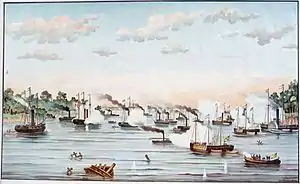Passage of Curupayty (1867)
The Curupaiti Crossing was an allied naval operation carried out on August 15, 1867, under the context of the Paraguayan War, which aimed to force the passage of Brazilian battleships against the defensive fortifications installed in the Curupaiti fort on the banks of the Paraguay river . There was a second crossing on February 13, 1868 with a fleet of armored monitors destined to find the fleet that had crossed first to form the squadron responsible for forcing the Passage of Humaitá.[1]
| 1st Passage of Curupayty | |||||||
|---|---|---|---|---|---|---|---|
| Part of the Paraguayan War | |||||||
 Passage of Curupaiti by Júlio Raison. | |||||||
| |||||||
| Belligerents | |||||||
|
| Paraguayan Army | ||||||
| Commanders and leaders | |||||||
|
|
| ||||||
| Strength | |||||||
|
18 Warships 3 Flat-bottomed boat | Curupaiti Fort with 35 cannons | ||||||
| Casualties and losses | |||||||
|
1 damaged warship 25 casualties | unknown | ||||||
The Passing
The difficulties faced by the allies were enormous. The war was already in its third year and they were trapped in a small area in southwest Paraguay, largely due to the disaster that had occurred about a year earlier in the Battle of Curupayty. An advertising victory was urgent to boost troops' morale. Humaitá was the main focus but Curupaiti was on the way.[2]
The high command of the Imperial Navy had considered forcing the passage over Curupaiti and Humaitá but considered it a practically impossible feat. Curupaiti was a group of fortifications and trenches, some kilometers downstream from the fortress of Humaitá, and part of the defensive complex of Humaitá.[1]
On August 15, 1867, at 6:40 am, the Brazilian Warships went into action. They were:
| Division | Ship | Commander |
|---|---|---|
| 2nd Division (Rodrigues da Costa) | Ironclad Brasil | Salgado |
| Armored corvette Mariz e Barros | Neves de Mendonça | |
| Ironclad Tamandaré | Elisiário Barbosa | |
| Ironclad Colombo | Bernardino de Queiroz | |
| Armored monitor Bahia (flagship) | Pereira dos Santos | |
| 1st Division (Tôrres e Alvim) | Ironclad Cabral | Gerônimo Gonçalves |
| Ironclad Barroso | Silveira da Mota | |
| Armored corvette Herval | Mimede Simões | |
| Ironclad Silvado | Macedo Coimbra | |
| Ironclad Lima Barros (flagship) | Garsino de Sá |
At this point, the river had two channels. One was deeper, but it was closer to the enemy batteries, and the current was stronger. In the other channel, the risk of stranding was very great; in addition, a Paraguayan defector claimed that torpedoes had been placed there recently. Inácio chose to follow the channel closest to the batteries, and his choice was correct. While the wooden vessels of the imperial navy suppressed fire, the warships crossed Curupaiti. Each ship took about 40 minutes to pass.[1]
Some ships were badly damaged. A shot penetrated the Tamandaré through one of its hatches, killing or injuring 14 of its crew. His engine had been damaged and stopped, leaving them adrift under the arms of the fort; he was rescued by Silvado, who threw a cable at them and took them in tow.Tamandaré commander Elisário Barbosa lost his left arm. According to Commander Kennedy, the accident with the Tamandaré forced Colombo, who was behind, to stop the engines to avoid a collision between the boats. The strong current placed them side by side, making maneuverability impossible. Colombo approached the Paraguayan cannons, which caused serious damage before he could leave his dangerous position. There were 25 Brazilian casualties including 3 dead. Warships, taking the channel closest to the Paraguayan cannons, escaped a more serious danger, as soon after the passage several torpedoes were found in the other channel.[3]
References
- Donato, Hernâni (1996). Dicionário das batalhas brasileiras (in Portuguese). São Paulo: Instituição Brasileira de Difusão Cultural. ISBN 978-85-348-0034-1. OCLC 36768251.
- Whigham, Thomas (2017). The Road to Armageddon: Paraguay Versus the Triple Alliance, 1866-70. University of Calgary Press. p. 117. ISBN 978-1-55238-809-9.
- Donato, Hernâni (1996). Dicionário das batalhas brasileiras (in Portuguese). IBRASA. ISBN 978-85-348-0034-1.